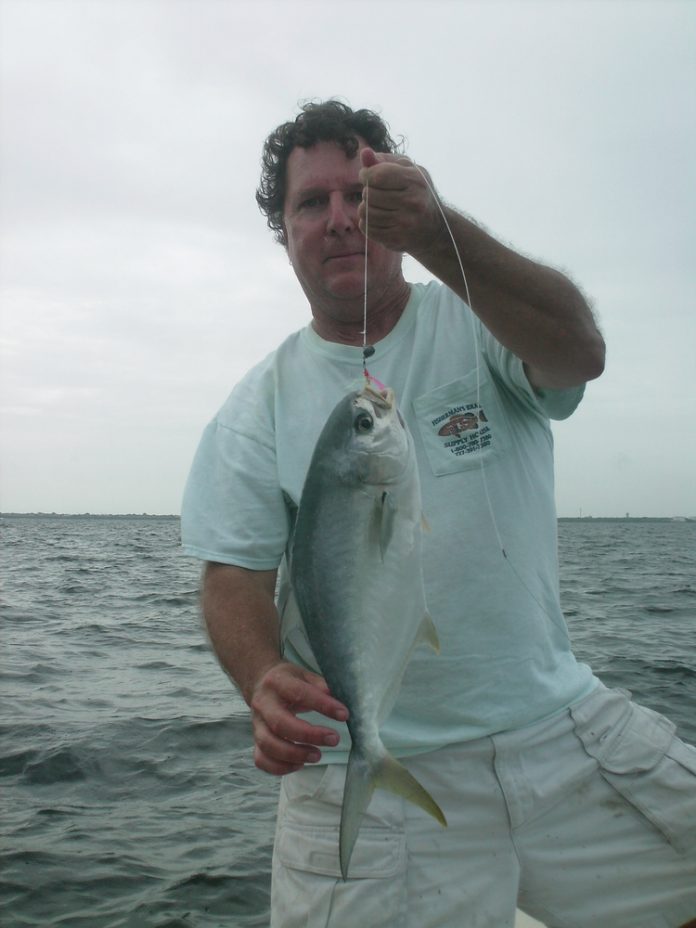Warmer and calmer weather returned to the Tampa Bay area this past week and visitors enjoyed some fine days and hot bites at the Sunshine Skyway Fishing Piers. A big kingfish hit the pavement on the North Pier and fish have been hooked & spotted on both piers. Jack crevalle schools of many different year-classes boiled the water near the piers and visiting anglers got a taste of what larger jacks can do to light spinning tackle! Spanish mackerel continued on a hot & cold feeding pattern that has characterized this species for the past 10 days, but the bite was getting better as the weekend approached. Gag grouper were on a great feed once again, but large numbers of short fish outpaced the keepers. Many anglers have reported seeing tripletail float through the pier spans with the tide – especially if there was a clump of seaweed on the surface to act as cover.
In what has been a slow start to kingfish season at the Skyway Piers, some good news appears to be on the horizon. More fish were spotted and hooked this past week than in the several weeks prior and a big fish was landed on the North Pier. This is not to say there have not been other kingfish landings this fall because many times fish are not reported – even if an angler is asked about such a catch. Visitors guessing that kingfish season had come & gone in the Tampa Bay region can take solace in the fact that many times kings are landed at the Skyway Piers well into the month of December. This is especially true in warmer years – as has been the case up until just the past few weeks. The forage that large kings so favor – blue runners, ladyfish and small jack crevalle – remain around both piers in outstanding numbers. Pier fishing for kings might seem intimidating to novice saltwater anglers, but the tackle truly could not be simpler. The next paragraph will explore some of the best methods for kingfish at the piers.
Free-lining sardines, herring or blue runners with a short length of coffee-colored hard wire in the 25 lb. – 40 lb. class with a 3/0 black nickel octopus-style hook is both deadly and effective. Some anglers even use 50 lb. class fluorocarbon leader material with a 2/0 long shank hook with great success. Stinger rigs are not very good for free-lining because the bait often dies too quickly with the pressure exerted from multiple hooks in conjunction with the tide. The next most popular kingfish method at the piers is the multiple rod ‘trolley’ system. Anglers put off by what appears to be a complex setup should check their concerns at the door. All the anchor rod does is provide a line/point from which baits are sent out on the fighting rods. The anchor rod does nothing else and is often not even retrieved until a day of fishing is complete. Use one (or several) shower curtain clips to send short lines (12″ – 18″) with a clothespin on the other end down the anchor rod line with baits. The clothespin holds the line of the fighting rod (or rods) essentially inline with the anchor rod. These baits can have multiple-hook stinger rigs because they are essentially stationary and will not pull the bait to death. All of the rods are placed in rod holders, and when a kingfish strikes the line of a fighting rod, that line pulls free of the anchor rod so as to fight the fish unencumbered.
Spanish mackerel were good once again this past week, but there remained plenty of both full limit days and days of just several fish. Spoons with silver, gold and white finishes fished behind a trolling sinker, bubble float or popping cork took the most fish this past week. Gotcha lures were right there as well, and many anglers took fish on various styles of jigs. Medium-sized scaled sardines were everywhere around the piers this past week and mackerel anglers fished them both live and cut with great success. It should be noted that the kingfish methods described above will also take the largest Spanish mackerel in the area, as well as give you a shot at sharks, tarpon, grouper and cobia.
The gag grouper bite has been outstanding all year at the piers, with each passing week judged mostly (and unfairly) on the number of keeper fish taken. Taking gags in the 16″ to 23″ range from a fixed position with medium light tackle is both challenging and extremely entertaining. Everyone wants that keeper, but these are beautiful and fine fighting fish to be cherished and released for another day in the Tampa Bay Estuary. Do not ignore night fishing for gags, with either free-lining pinfish or pigfish, or casting diving plugs. Some very large gags are taken after sundown at the piers each season.
Tripletail have been compared to a saltwater version of the freshwater bluegill – extremely powerful & mighty tasty – except that tripletail can exceed 30 lbs. on the scale! Young tripletail spend their first years in bays, estuaries and other nearshore environments. Adults are often offshore pelagic fish, seeking out shipwrecks and other debris to which to relate. The Skyway Piers see both adult & juvenile versions of this fish because of the debris and other floating materials often swept in and out of Tampa Bay with strong tidal cycles. The species is often very aggressive, and a shrimp or pass crab placed in the vicinity of a floating mat of vegetation holding fish often gets a strike. Some anglers prefer artificial lures – like imitation shrimp or a jig & soft plastic combination.
- The Skyway, Paul Bristow - August 24, 2018
- The Skyway, Paul Bristow - August 17, 2018
- The Skyway, Paul Bristow - August 10, 2018











